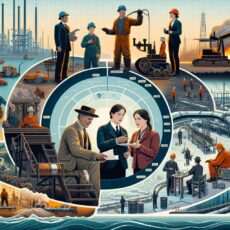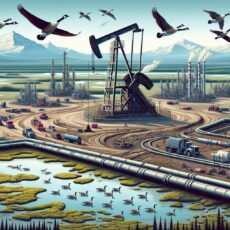The oil and gas industry in Canada has long been a cornerstone of the nation’s economy, providing employment opportunities and contributing significantly to the country’s GDP. However, despite its importance, this sector has faced numerous unforeseen challenges over the years. In this article, we will delve into some of the most perplexing hurdles that the oil and gas industry in Canada has encountered and explore how it has tried to overcome them.
One of the key challenges faced by the oil and gas industry in Canada is the fluctuating prices of crude oil. The global market for oil is highly unpredictable, influenced by various factors such as geopolitical tensions, economic stability, and technological advancements. As a result, oil prices can experience drastic fluctuations, and this volatility affects the profitability and viability of oil and gas operations in Canada. The industry has had to adapt to these unpredictable price swings, implementing strategies to manage costs, improve efficiency, and explore alternative revenue streams.
Another significant challenge is the regulatory framework governing the oil and gas industry in Canada. Over the past few decades, there has been an increased focus on environmental protection and sustainability. This has led to stricter regulations surrounding emissions, water usage, and overall environmental impact. While these regulations are necessary for the preservation of natural resources and mitigation of climate change, they have presented significant obstacles for the industry. Oil and gas companies have had to invest in innovative technologies, such as carbon capture and storage, and implement sustainable practices to align with these regulations and maintain their social license to operate.
Furthermore, the transportation of oil and gas resources across vast distances has proven to be a complex and challenging task. Canada is known for its vast reserves of oil and gas, but many of these reserves are located in remote and geographically challenging areas, such as the oil sands in Alberta or offshore drilling sites on the Atlantic coast. To transport these resources to refineries and markets, extensive pipeline networks, railways, and shipping infrastructure are required. However, the development of such infrastructure often faces opposition from environmental groups, indigenous communities, and concerned citizens. This opposition has resulted in delays, legal battles, and increased project costs. The industry has had to engage in extensive consultation and work towards building trust and mutual understanding with stakeholders to move forward with these crucial infrastructure projects.
In addition to these challenges, the oil and gas industry also faces immense pressure from public opinion and societal shifts towards renewable energy sources. As concerns about climate change and the depletion of finite resources grow, there is a greater demand for cleaner, greener energy alternatives. This shift in public sentiment has led to divestments from fossil fuel companies, increased scrutiny of their environmental impact, and a push for renewable energy initiatives. The oil and gas industry in Canada has recognized the importance of diversifying its energy portfolio and investing in renewable technologies, such as wind and solar. This transition, however, requires substantial capital investments and a shift in mindset within the industry.
In conclusion, the oil and gas industry in Canada has encountered numerous unforeseen challenges throughout its existence. From volatile oil prices to stringent regulations, transportation obstacles, and the evolving energy landscape, the industry has had to adapt and innovate to survive. These challenges have tested the resilience and creativity of the sector, forcing it to reimagine its operations and work towards a more sustainable future. By embracing technological advancements, engaging with stakeholders, and recognizing the need for diversification, the oil and gas industry in Canada can navigate the perplexing path ahead and continue to contribute to the nation’s economy while mitigating its environmental impact.


